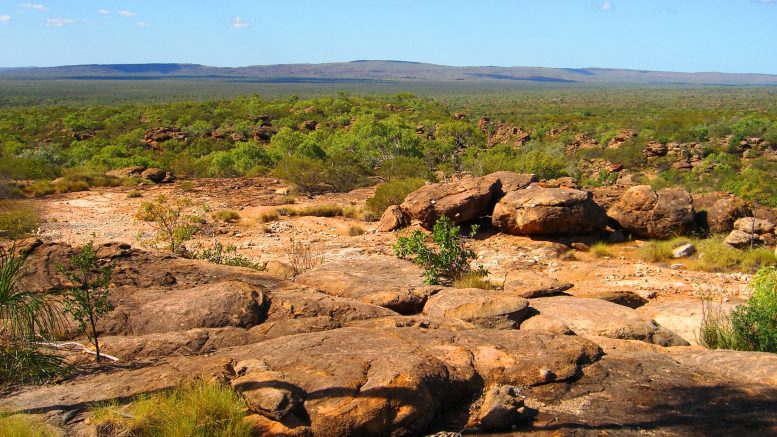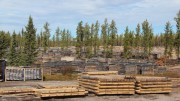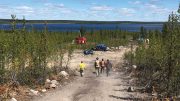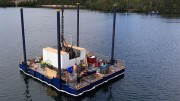With uranium oxide prices making a rebound over the last two months after hitting 12-year lows, uranium juniors are seeing renewed interest from investors. Here are six such companies worth noting.
LARAMIDE RESOURCES
Toronto-based, Marc Henderson-led Laramide Resources (TSX: LAM; US-OTC: LMRXF; ASX: LAM) has early-stage uranium assets in Australia and the southwest U.S., with its flagship in recent years being the wholly owned Westmoreland project in northwest Queensland near the Mt. Isa mining district.
Westmoreland was once owned by Rio Tinto, and has a sandstone-hosted resource of 52 million lb. uranium oxide (U3O8) in 18.7 million indicated tonnes grading 0.089% U3O8 and 9 million inferred tonnes at 0.083% U3O8.
An updated preliminary economic assessment on the project foresees relatively straightforward open-pit mining with mild acid tank leaching for recovery. Some 80% of the resource is within 50 metres from surface.
In the U.S., Laramide has recently acquired the Churchrock and Crownpoint uranium assets in New Mexico from Uranium Resources, which Laramide says “creates a leading in-situ recovery division in a tier-one jurisdiction with enhanced project economics and low operating costs.” Laramide says they are “production ready” and it has most permits in hand for a low initial capital-cost, staged ramp-up in production.
In relation to the Churchrock and Crownpoint acquisitions, Laramide closed an equity financing that raised $4.5 million.
Laramide also has two hard-rock uranium properties in the U.S.: La Sal in Utah, which is production-ready; and La Jara Mesa in New Mexico, where permitting is almost complete.
MEGA URANIUM
Mega Uranium (TSX: MGA) is another Toronto-based junior with uranium assets in Australia, but the junior has been in slumber mode since mid-2015.
Mega’s flagship project is Ben Lomond, 50 km west of the port city of Townsville, Queensland, which the company has developed since acquiring it in 2006.
The deposit was found in 1975 and had a feasibility study completed in 1982, but further mine development was halted by the national government’s three-mine policy, which prevented any new uranium mines coming online in Australia for many years.
At last count, Ben Lomond’s National Instrument 43-101 compliant resource stood at 1.3 million indicated tonnes grading 0.3% U3O8 (7.9 million lb. U3O8) and 0.6 million inferred tonnes at 0.2% U3O8 (2.8 million lb. U3O8), plus a molybdenum credit at an average grade of 0.15% molybdenum.

Carnotite mineralization (a uranium ore mineral) in rock at Mega Uranium’s Ben Lomond uranioum property in Queensland, Australia. Credit: Mega Uranium.
Mega says Ben Lomond’s “relatively high average 0.3% U3O8 grade and substantial molybdenum credit” makes the deposit “one of the highest value-per-tonne uranium resources outside the Athabasca basin in Canada.”
Despite the company’s relative inactivity of late, its shares are up 75% in January 2017, as the company rides the wave of renewed interest in the uranium sector as uranium prices rebound.
PISTOL BAY MINING
Pistol Bay Mining (TSXV: PST) is developing its portfolio of precious and base metal projects in Ontario’s Red Lake camp, but the junior has a connection to uranium in the form of its C-4-5-6 property in Saskatchewan’s Athabasca basin.
Rio Tinto (NYSE: RIO) has an option agreement on the C-4-5-6 property, and in late January resumed exploring the 10 sq. km C5 property, where it will drill 2,600 metres in four to six diamond drill holes to target uranium mineralization at the unconformity between Athabasca basin sediments and older basement rocks (at 400 metres deep on the property), and in the basement itself.
The C5 property adjoins Denison Mines’ (TSX: DML; NYSE-MKT: DNN) 60%-owned Wheeler River uranium property and is 4.5 km north of the Phoenix uranium deposit, 5 km northeast of the Gryphon uranium deposit, and 2.6 km northeast of the 489 Uranium zone.

Pistol Bay Mining and Rio Tinto’s C-4, C-5 and C-6 uranium properties in Saskatchewan’s Athabasca basin. Credit: Pistol Bay Mining.
Rio Tinto has already earned a 75% interest in the C-4-5-6 property, and Pistol Bay says Rio Tinto intends to exercise its option to acquire full interest by paying Pistol Bay $5 million before 2020 and granting Pistol Bay a 5% net profits interest.
Rio Tinto has already completed 12 diamond drill holes totalling 6,100 metres on the C5 property, as well as a gravity survey and a direct-current resistivity survey.
Rio Tinto’s best hole so far at C5 is from hole 14CBK003, which was drilled in 2014 and intersected 0.054% U3O8 over 1.5 metres, though core recovery was only 50%.
Pistol Bay notes that the C 4-5-6 property is accessible by road, and the 75 km, all-weather haul road from the McArthur River mine to Cameco’s Key Lake mine and mill passes within 5 km.
PLATEAU URANIUM
Plateau Uranium (TSXV: PLU) is all about Peru, and its advanced Macusani Plateau uranium project, 220 km north of Juliaca in the country’s south. There, Plateau and its predecessors have spent US$45 million over the last eight years drilling, consolidating ground and growing a resource in five deposits that stands at 51.9 million lb. U3O8 in the measured and indicated categories (95.2 million tonnes at 0.0248% U3O8), and 72.1 million lb. U3O8 in inferred (130 million tonnes at 0.0251% U3O8).

Plateau Uranium CEO Ted O’Connor at the company’s Tantamaco uranium deposit in southern Peru. Credit: Plateau Uranium.
The work culminated in last year’s preliminary economic assessment that foresees a large open-pit mine that would produce at least 6 million lb. U3O8 per year over 10 years at a US$17 per lb. life-of-mine cash production cost. With US$300 million in initial capital investment and at a US$50 per lb. uranium oxide price, the net present value is US$603 million and the internal rate of return is 40.6%, with post-tax capital payback in 1.8 years.
The resource also has a potential lithium (Li2O) by-product, with 67,000 tonnes Li2O in measured and indicated (grading 0.1% Li2O) and 109,000 tonnes Li2O in inferred (0.1% Li2O). Initial tests show 73% recovery of lithium using leaching.
Plateau has a US$4- to US$5-million program from 2016–2017 that includes environmental work, drilling for discovery and resource upgrades, permitting and discussions with government, metallurgical test work and starting studies to finish a prefeasibility study. All this would pave the way for a bankable feasibility study in 2018.
U3O8 CORP.
Richard Spencer-led U3O8 Corp. (TSX: UWE, US-OTCQB: UWEFF) has early-stage uranium projects in Argentina, Colombia and Guyana, with its most advanced being its Laguna Salada project in Argentina.
Although Laguna Salada only has 10.1 million lb. U3O8 in the measured and inferred categories, U3O8 Corp. considers this its most advanced asset because the uranium is hosted in a flat, 1-metre-thick, near-surface gravel layer that could be put into production relatively quickly at a US$138-million capital expense.

Trenching at U3O8 Corp.’s Laguna Salada uranium property in Argentina’s Chubut province. Credit: U3O8 Corp.

Measuring high levels of radioactivity using a scintillometer on uranium-rich soil at U3O8 Corp.’s Laguna Salada property in Argentina. Credit: U3O8 Corp.
With near real-time backfilling and remediation of mined areas, there would be no open pit left behind after mining operations — in effect “cleaning up” the uranium from the land.
The company says processing would be “simple,” with uranium and vanadium extracted at 80°C using baking soda and washing soda.
In January 2017, the company announced uranium and vanadium assays from exploration trenching of soft gravel and sand in the La Rosada area, which the company considers an extension of the Laguna Salada deposit, 50 km south.
“Our focus on exploration for higher-grade extensions to the Laguna Salada deposit had led to the discovery of uranium and vanadium in a layer adjacent to, and beneath, gravel in the La Rosada area,” Spencer said in a release. “That was an unexpected bonus because our target was uranium and vanadium in the gravel itself.”
URANIUM PARTICIPATION
Uranium Participation (TSX: U; US-OTC: URPTF) is an unusual uranium investment vehicle, in that the Toronto-based firm invests solely in uranium concentrate on a “buy and hold” basis, and is geared to make money on long-term increases in uranium prices, without speculating on short-term price fluctuations.
The firm says its typical investor profile is a commodity-focused or generalist investor looking for exposure to uranium prices, who would appreciate that Uranium Participation holds physical uranium in inventory, has no mineral resource or project risks, no mine or processing operating risks, and directs at least 85% of the net proceeds of any equity offering into uranium holdings.
While it is publicly traded, Uranium Participation is not an exchange-traded fund or an open-end fund. Emerging uranium miner Denison Mines (TSX: DML; NYSE-MKT: DNN), part of the Lundin Group of Companies, serves as Uranium Participation’s manager under a management services agreement, and takes direction from Uranium Participation’s independent board of directors.
As of Oct. 31, 2016, Uranium Participation held uranium oxide in concentrate totalling 9.47 million lb. and worth $238 million, plus uranium hexafluoride of 1.9 million KgU worth $140 million, for a total “uranium fair value” of $378 million.

Uranium Participation’s uranium portfolio as of Oct. 31, 2016. Credit: Uranium Participation November 2016 Investor Update.






I assume you are referring to small juniors since you are missing Denison, Fission and NexGen.
Peter, we’ve run three feature length stories on Denison, Fission and NexGen just within the last week:
Denison CEO on becoming Canada’s next uranium producer
http://www.northernminer.com/news/denison-ceo-becoming-canadas-next-uranium-producer/1003782870/
Fission Uranium execs talk 2017 drill strategy at PLS
http://www.northernminer.com/news/fission-management-talks-2017-drill-strategy-pls/1003782903/
NexGen Energy starts 2017 drill program at Arrow
http://www.northernminer.com/news/nexgen-starts-2017-drill-program-arrow/1003782767/
I appreciate the information you make available for investors.
What about U.S. based Western Uranium???